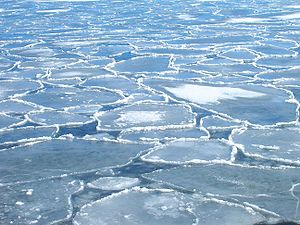 |
| Melting ice (Photo credit: Wikipedia) |
"Direct observations of sea ice go back a surprisingly long way: a Greek navigator, Pytheas of Massilia, sailed into the open Atlantic in 325 BCE, reaching: a land he called "Eschate Thule," where the Sun only set for three hours each day and the water was replaced by a congealed substance "on which one can neither walk nor sail." He was probably describing loose sea ice known today as "growlers," or "bergy bits."
Niflheim, which sounds just like the Arctic ice was the first world in ancient Norse mythology. Its snow- and ice-melt gave rise to the frost giant Ymir, from whose body the whole cosmos was formed. Today, science tells us a different story about the sea ice, but in that story, too, the ice is far older than humans.
According to Polyak et al. (2010):
…sea ice became a feature of the Arctic by 47 [million years before the present], following a pronounced decline [in carbon dioxide concentrations]… Ice was apparently most widespread during the last 2–3 million years, in accordance with Earth's overall cooler climate.Since modern humans are just 200,000 years old, the ice might as well be eternal. But not unchanging. We live in that part of an ice age that is termed an interglacial, when some of the ice retreats in summer. During modern human history the ice cap has melted back each summer as Earth tipped toward the sun, then grown again with new freezing as the year turned toward the Winter solstice.
Polyak et al. continues:
Nevertheless, episodes of considerably reduced sea ice or even seasonally ice-free conditions occurred... The current reduction in Arctic ice cover started in the late 19th century, consistent with the rapidly warming climate, and became very pronounced over the last three decades. This ice loss appears to be unmatched over at least the last few thousand years…His "Thule" was probably Norway…
This information is based upon the detailed study of ‘proxies’—indirect indicators of sea ice extent, including sea-floor sediments containing distinctive mineral, chemical and biological markers; coastal records which include things as diverse as ancient driftwood and geological beach formations; ice-cores from nearby land ice; and tree-ring records, where available.
Direct observations of sea ice go back a surprisingly long way: a Greek navigator, Pytheas of Massilia, sailed into the open Atlantic in 325 BCE, reaching: a land he called "Eschate Thule," where the Sun only set for three hours each day and the water was replaced by a congealed substance "on which one can neither walk nor sail." He was probably describing loose sea ice known today as "growlers," or "bergy bits."
Since then, humans have repeatedly encountered the ice, from 11th century Novaya Zemlya, to the Norse colony in Medieval Greenland, to Henry Larsen’s 1944 transit of the Northwest Passage. For many it proved a fatal encounter; the names of Hugh Willoughby, Willem Barents, Henry Hudson, and John Franklin would only begin a list of Arctic explorers who bartered their lives for their discoveries. During this time, the annual melt and refreeze of the ice has been relatively consistent.
But that has changed. Since the turn of the millennium, transits of Northwest and Northeast Passages have increased dramatically. In the Northeast, millions of tons of supertanker traffic have passed already, and Russian infrastructure investments indicate that this is a mere beginning. In the Northwest, Arctic charter cruising has become a growing industry. In both, recreational boaters are increasingly common; and many of them now report that they see no pack ice at all.
By Neven Acropolis & Kevin McKinney
Read More At: http://climatechangepsychology.blogspot.gr/2012/08/why-arctic-sea-ice-shouldnt-leave.html




